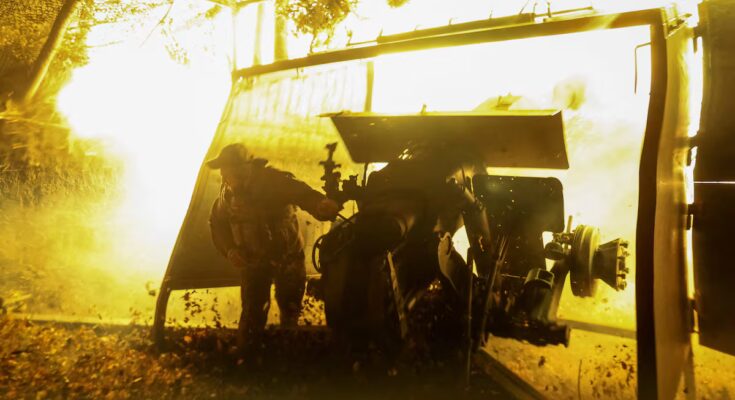There are two cities in eastern Ukraine where street-to-street clashes are taking place. These are the two conquests currently most desired by the Russian army: one is Pokrovsk, in the Donetsk province, and the other is Kupiansk, in the Kharkiv province. Both are places of great strategic importance, but if everything indicates that Pokrovsk could soon fall into the hands of the invader, Ukrainian troops have so far managed to overturn a defeat taken for granted in the summer in Kupiansk.
Reinforcements added this summer, better coordination between brigades, local advantages and the concentration of Russian troops on Pokrovsk have allowed the Ukrainian Armed Forces to continue to resist the Kupiansk bastion.
On the screen of the command post of Magnet, code name of the commander of the 151st Ukrainian assault and reconnaissance battalion, a smoking building appears. Their bomb drones are punishing this apartment block in the center of Kupiansk. The defense forces believe that Russian soldiers have taken refuge there. An hour after hitting the building, observation drones transmit images of six human figures exiting the portal carrying bags. They are civilians who run to take refuge in a basement of the nearby building. Magnet immediately calls off the attack and asks the troops on the ground to go to the shelter to confirm that they are not from the enemy side.
Within minutes two Ukrainian stormtroopers burst into the basement. Shortly afterwards they confirm that they are civilians and leave the place to a safe location. The group of neighbors will remain there. “Evacuating them is impossible, it would cause casualties among our men and among us,” says Magnet. This officer estimates that 800 civilians remain in Kupiansk, out of a pre-war population of 26,000. The city has a peculiarity: it is the first large municipality that can be occupied for the second time by Russia. Russian authorities took control of it in February 2022, although it was liberated during the Ukrainian counteroffensive in September of the same year.
The command center of the 151st Battalion is located 25 kilometers from Kupiansk, i.e. on the border of the so-called “death zone”, the distance from the front line where the danger is particularly high due to the intense activity of enemy drones. An example of this is provided by four soldiers of a National Guard artillery brigade who have their Grad rocket battery about seven kilometers from the city. They say that if in May they could reach their position in a few hours, even without the need to wear a helmet and bulletproof vest, today it could take days to be able to maneuver their Grads, waiting for the opportunity to avoid the flight of Russian bomb drones. “On the road we have 10 cars destroyed by drones,” says one of them.
But the scene seen by EL PAÍS on November 6 on the monitors of the 151st battalion demonstrates that the Ukrainian Armed Forces have the situation under control in the municipality, despite it being a gray area, that is, without either side dominating the terrain. Compared to last August and September, when the Russian advance in the urban area was lightning-fast, the situation has improved for Ukrainian interests. They not only stopped the invader inside Kupiansk: President Volodymyr Zelensky declared on November 7 that his men had pushed the invader back more than a kilometer into the outlying neighborhoods.
The new Russian infantry added to Kupiansk has not been trained for defense (the invader has been on the offensive for two years), Magnet points out. Furthermore, in this region of the front the enemy has not built the defensive fortifications that it had built in Donetsk and in the south, in Zaporizhzhia, during the failed major Ukrainian counteroffensive of 2023. That is why, says the commander of the 151st battalion, they can recover positions.
Accent, the code name of a battalion commander of the Ukrainian 43rd Mechanized Brigade, confirms that with more troops, his army could advance on Kupiansk. “The Russians want a big political victory as soon as possible, whether it’s Pokrovsk or Kupiansk, and our big problem is that we lack soldiers,” Accent says. This colonel estimates that his men can remain in position, without rotation to rest, for 200 days. In the first year of the war infantry rotations were weekly.
Another key factor in improved Ukrainian resistance in Kupiansk, according to testimony from officers from four brigades consulted by this newspaper, was not only the reinforcements transferred to the area over the summer, but also that, unlike in Pokrovsk, nature is a first-class ally.
The first thing that surprises you on the roads that connect Kharkiv, the provincial capital, with Kupiansk, is the intense movement of armored vehicles, both infantry and tanks. The use of these vehicles in other sectors of the front has been drastically reduced because they are easy prey for drones. But Kupiansk’s western flank, where Ukrainian troops enter the municipality, is surrounded by vast areas of forest. Among the trees, with greater safety, the soldiers rotate with these armored vehicles, up to the first streets of the city.
The opposite is what happens in Pokrovsk, where access to the city by the Ukrainian army is so difficult that the Ministry of Defense special forces reinforcements arriving on November 3 had to do so in an almost suicidal mission, by helicopter.
Privid is not yet 30 years old and has already fought as an assaulter in some of the most important battles of this war. He is an officer in the 15th National Guard Brigade, in Kupiansk, but knows Pokrovsk inside and out, having been stationed there a year ago. He still has companions in this city besieged by the Russians, and he points out that the good fortune of Kupiansk is that the invader does not allocate as many resources as in Pokrovsk. An example of this, says Privid, is the number of aerial bombs that Russia drops on Ukrainian positions in the two enclaves: if between 50 and 100 Russian aerial bombs are dropped against Pokrovsk per day, in Kupiansk they do not exceed 20.
Privid admits that “soldier morale is terrible” due to the lack of replacements and that Russia, despite suffering three times more casualties than the defending army, according to counts by independent war analysis organizations, does not stop attacking positions with its infantry.
The Oskil River Barrier
But the Russians have another disadvantage in Kupiansk, Magnet explains, because to supply their soldiers inside the city they must cross the Oskil River, which surrounds Kupiansk on the eastern flank. “Every time they try to build a jetty in the river, we destroy it, so the ammunition and resources their men receive in the urban center are reduced.” They can’t even move large supply drones for their soldiers, only small unmanned ground vehicles with a maximum payload of eight kilos, Magnet says.
Accent claims that the Russians “have huge logistical problems” and that, to redress the balance, they have concentrated 80% of their artillery and attack drone fire against Ukrainian drone pilot bases since August.
Accent’s battalion defends the village of Kupiansk-Vuzlovii, just south of Kupiansk. This is the main Ukrainian bastion on the left bank of the Oskil, a fundamental place to prevent the enemy from securing the passage of the river. Kupiansk-Vuzlovii is also an important railway hub for Lugansk, a Russian-occupied province.
If Kremlin troops expel the Ukrainians from the area and secure control of Oskil, Accent and Magnet agree, the defeat would represent a major strategic failure for Ukraine, because the invader could supply its army with trains, have Kharkiv’s logistics routes and the last nodes connecting this province with the 30% of neighboring Donetsk still under the control of Free Ukraine. The 43rd Brigade colonel warns that this setback would not only make it more difficult to one day return to reclaim Lugansk, but would provide Russia with a platform to advance toward Kharkiv in the future.



